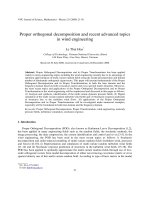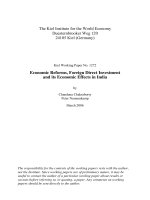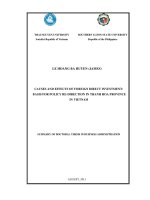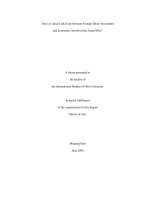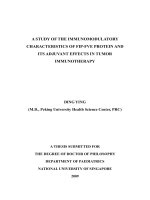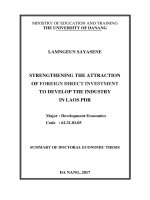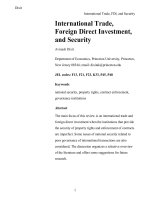Tài liệu Economic Reforms, Foreign Direct Investment and its Economic Effects in India pdf
Bạn đang xem bản rút gọn của tài liệu. Xem và tải ngay bản đầy đủ của tài liệu tại đây (207.25 KB, 45 trang )
The Kiel Institute for the World Economy
Duesternbrooker Weg 120
24105 Kiel (Germany)
Kiel Working Paper No. 1272
Economic Reforms, Foreign Direct Investment
and its Economic Effects in India
by
Chandana Chakraborty
Peter Nunnenkamp
March 2006
The responsibility for the contents of the working papers rests with the author,
not the Institute. Since working papers are of preliminary nature, it may be
useful to contact the author of a particular working paper about results or
caveats before referring to, or quoting, a paper. Any comments on working
papers should be sent directly to the author.
Economic Reforms, Foreign Direct Investment
and its Economic Effects in India
Abstract: Foreign direct investment (FDI) has boomed in post-reform India.
Moreover, the composition and type of FDI has changed considerably since
India has opened up to world markets. This has fuelled high expectations that
FDI may serve as a catalyst to higher economic growth. We assess the growth
implications of FDI in India by subjecting industry-specific FDI and output data
to Granger causality tests within a panel cointegration framework. It turns out
that the growth effects of FDI vary widely across sectors. FDI stocks and output
are mutually reinforcing in the manufacturing sector. In sharp contrast, any
causal relationship is absent in the primary sector. Most strikingly, we find only
transitory effects of FDI on output in the services sector, which attracted the
bulk of FDI in the post-reform era. These differences in the FDI-growth
relationship suggest that FDI is unlikely to work wonders in India if only
remaining regulations were relaxed and still more industries opened up to FDI.
Keywords: foreign direct investment, economic reform, growth effects, India,
cointegration, causality
JEL classification: F21, F23, O53
Corresponding authors:
Chandana Chakraborty Peter Nunnenkamp
School of Business Kiel Institute for the World Economy
Montclair State University P.O. Box 4309
Upper Montclair, NJ D-24100 Kiel
U. S. A. Germany
Phone: ++01-973-655-4125 Phone: ++49-431-8814209
Fax: ++01-973-655-4456 Fax: ++49-431-8814500
E-mail: E-mail:
1
I. Introduction
The stock of foreign direct investment (FDI) in India soared from less than US$
2 billion in 1991, when the country undertook major reforms to open up the
economy to world markets, to almost US$ 39 billion in 2004 (UNCTAD online
database). Currently, it is being discussed to deregulate FDI restrictions further,
e.g., by allowing FDI in retail trade. Policymakers in India as well as external
observers attach high expectations to FDI. According to the Minister of Finance,
P. Chidambaram, “FDI worked wonders in China and can do so in India”
(Indian Express, November 11, 2005). The Deputy Secretary General of the
OECD reckoned at the OECD India Investment Roundtable in 2004 that the
improved investment climate has not only resulted in more FDI inflows but also
in higher GDP growth (OECD India Investment Roundtable 2004). The implicit
assumption seems to be that higher FDI has caused higher growth.
1
Bajpai and
Sachs (2000: 1) advise policymakers in India to throw wide open the doors to
FDI which is supposed to bring “huge advantages with little or no downside.”
Yet, as we discuss in more detail in Section II, it is far from obvious that FDI
in India will have the desired effects. Skepticism may be justified for several
reasons. The recent boom notwithstanding, FDI inflows may still be too low to
make a big difference. For instance, Kamalakanthan and Laurenceson (2005)
suspect that FDI cannot reasonably be considered an important driver of
economic growth in India because its contribution to gross fixed capital
1
Fischer (2002) makes this assumption explicit when stating that greater openness to FDI
would permit a significant increase in growth in India.
2
formation has remained small.
2
Moreover, some observers doubt that economic
reforms went far enough to change the character of FDI in India and, thus, result
in types of FDI that may have more favorable growth effects. For example,
Balasubramanyam and Mahambare (2003) as well as Fischer (2002) argue that
the reforms implemented so far have not eliminated the distinct anti-export bias
of India's trade policy. This may explain why, according to Arabi (2005) and
Agarwal (2001), FDI in India has remained domestic market seeking.
It is widely believed that the type of FDI and its structural composition
matter at least as much for economic growth effects as does the overall volume
of inward FDI. Agrawal and Shahani (2005) reckon that it is the quality of FDI
that matters for a country like India rather than its quantity.
3
FDI is often
supposed to be of higher quality if it is export oriented, transfers foreign
technologies to the host country, and induces economic spillovers benefiting
local enterprises and workers (Enderwick 2005). All the more surprisingly, the
structure and type of FDI are hardly considered in previous empirical studies on
the FDI-growth links in India.
Against this backdrop, this paper raises two major questions: First, we assess
in Section III whether India's reforms in 1991, apart from giving rise to FDI,
have also induced changes in the structure and type of FDI which may be
2
See also Bhat et al. (2004: 182).
3
According to Agrawal and Shahani (2005: 644), "the worst case could be when FDI moves
into an economy just to produce for the domestic markets … as its ultimate aim is to
displace the local industry." In sharp contrast, Palmade and Anayiotas (2004: 3) criticize the
“general misconception that market-seeking FDI in domestic sectors such as retail yields
little development impact.”
3
relevant for its growth impact. Second, we evaluate in Section IV whether the
growth impact of FDI differs between the primary, secondary and tertiary
sectors. We apply cointegration and causality analyses on the basis of industry-
specific FDI stock data which are available for the period 1987-2000.
We find some support to the proposition that the character of FDI in India has
changed in the post-reform period, though possibly not to the extent as the
proponents of a further liberalization of FDI regulations might implicitly
assume. Moreover, the growth impact of FDI is shown to differ significantly
across sectors. Most notably, there is at best weak evidence for a causal link
between FDI and output growth in the services sector, which attracted the bulk
of additional FDI in recent years. This leads us to conclude that the current
euphoria about FDI in India rests on weak empirical foundations. FDI is rather
unlikely to work wonders in India.
II. Earlier Literature and Open Questions
Several earlier studies on the growth impact of FDI in India are in striking
contrast to the currently prevailing euphoria. Agrawal (2005) estimates a fixed
effects model based on pooled data for five South Asian host countries, among
which India figures prominently, and the period 1965-1996. The coefficient of
the FDI-to-GDP ratio turns out to be negative, though not significant. However,
this approach ignores that FDI is endogenous. Moreover, the inclusion of
exports as a right hand side variable may bias the coefficient of the FDI variable
downwards to the extent that the growth impact of FDI may run through export
4
promotion. Similar qualifications apply to Pradhan (2002) who estimates a
Cobb-Douglas production function with FDI stocks as additional input variable.
FDI stocks have no significant impact when considering the whole period of
observation (1969-1997).
Most studies accounting for the fact that causation may run both ways tend to
find that higher growth leads to more FDI, rather than vice versa. Chakraborty
and Basu (2002) explore the two-way link between FDI and growth by using a
structural cointegration model with vector error correction mechanism. Using
aggregate data for 1974-1996, they find that causality runs more from GDP to
FDI. In the long run, FDI is positively related to GDP and openness to trade.
Furthermore, FDI plays no significant role in the short-run adjustment process of
GDP. In an earlier study, Dua and Rashid (1998) report similar results. Kumar
and Pradhan (2002) consider the FDI-growth relationship to be Granger neutral
in the case of India as the direction of causation was not pronounced. Sahoo and
Mathiyazhagan (2002) corroborate what appeared to be the consensus until
recently, while the Granger causality and Dickey-Fuller tests presented by Bhat
et al. (2004) provide no evidence of causality in either direction.
4
Several explanations have been offered for the at best weak impact of FDI on
growth in India. The Asian Development Bank refers to concerns in India
4
Sahoo and Mathiyazhagan (2002: 17-18) conclude: "FDI does not matter in the growth of
the economy. It implies that India's progress towards 'market oriented economy' through
policy reforms in 1991 … has not worked properly." However, in the published version of
the same paper, Sahoo and Mathiyazhagan (2003) come to exactly the opposite conclusion:
"India's progress to 'market oriented economy' … in the 1980s and the early 1990s … has
worked properly. FDI inflow has played a vital role in the Indian economy."
5
“about the apparently limited linkages between MNEs and local firms” (ADB
2004: 228). According to Kumar (2003: 27), linkages with the local economy
have remained weak even in the software industry where foreign companies are
said to operate as “export enclaves.”
5
Bhat et al. (2004) suspect that a lack of
local skills has prevented economic spillovers from foreign to local companies.
A more differentiated picture is portrayed by Kathuria (2002), who argues that
only those domestic firms which invested in R&D, in order to make use of
foreign technologies, benefited from spillovers. Athreye and Kapur (2001: 418)
note that, according to surveys conducted in the early 1990s, almost half of
foreign investors did not transfer up-to-date technology to their Indian
subsidiaries or joint-venture partners as intellectual property protection was
considered too weak. In the chemical industry, which figured most prominently
as a target of FDI until the mid-1990s (see Section III), 80 percent of foreign
investors referred to this problem, which may have inhibited more favorable
growth effects. At the same time, Kumar and Agarwal (2000) show that local
R&D intensity of foreign companies was lower than that of domestic companies,
once other factors are controlled for.
Another explanation, which has received particular attention in the literature,
concerns FDI-induced exports as a possible transmission mechanism from FDI
to GDP growth. Findings have remained ambiguous. In some contrast to Kumar
(1990), Sahoo (1999) shows that foreign firms had somewhat higher export
5
In addition, Kumar (2003) suspects that at least some FDI inflows have crowded out local
investment.
6
ratios than comparable domestic firms in selected industries in 1990-1994.
However, several studies are more in line with the ADB’s (2004: 224) verdict
that FDI accounts for a “trivial share” of India’s exports.
6
According to Sharma
(2000), FDI had no significant impact on the country’s export performance.
7
Pailwar (2001) argues that India has not been able to attract FDI in export
oriented areas. Banga (2003) agrees that FDI has not played a significant role in
export promotion, but points out that export effects differ between home
countries of foreign investors and between traditional and non-traditional export
industries.
8
It is open to question which of these findings still apply. Earlier studies may
fail to fully capture the effects of the changing policy framework in the post-
reform period. The ADB (2004: 244) expects a fundamental shift in the behavior
of foreign investors and in the benefits host countries may derive from FDI
when the policy environment changes as it did after India’s reform program of
1991. The New Industrial Policy, triggered by the severe liquidity crisis and the
ensuing structural adjustment program agreed with the IMF, marked the
departure from restrictive FDI regulations and included the liberalization of
trade barriers.
9
Policy changes relevant to FDI included: automatic approval of
6
According to this source, FDI accounts for about 3 percent of India’s exports, compared
with 50 percent or more in various East Asian host countries.
7
See also Athreye and Kapur (2001: 414-415).
8
It turns out that US FDI has a positive impact on the export intensity of non-traditional
export industries, whereas Japanese FDI has not.
9
The extremely short account of India’s reform program draws on Kumar (2003),
Balasubramanyam and Mahambare (2003), Agrawal (2005) and Gupta (2005). As noted by
7
FDI projects meeting certain conditions; opening up to FDI in various sectors,
including mining, financial services and telecommunication (though still subject
to limits of foreign ownership); lifting foreign ownership restrictions in most
manufacturing industries; gradual dismantling of performance requirements;
10
and incentives for companies operating in export processing zones, the number
of which increased. Trade policy reforms that may have induced more world-
market oriented FDI included sharply reduced import tariffs.
11
Even if one rejects the view of Gupta (2005: 199) that “India fully liberalized
its economy and became completely open to FDI”, the reforms appear to be
comprehensive enough to have a say on both the type of FDI entering India and
the economic impact of FDI. The liberalization of technology policy seems to
have had the effect that foreign investors increasingly entered into technical
collaboration agreements, most of which involved some form of financial and
equity participation (Athreye and Kapur 2001: 418). Moreover, if Gupta (2005)
is right in that India's earlier import substitution strategy had impaired the
economic benefits to be derived from FDI, trade liberalization should have
resulted in larger benefits. As a consequence of trade liberalization, India may
no longer belong to the group of relatively closed host countries for which,
Balasubramanyam and Mahambare, the relaxation of the dirigiste trade and FDI regime
started in the mid-1980s already.
10
However, balancing requirements with respect to foreign exchange were relaxed only
recently.
11
Agrawal (2005: 97) notes that the average weighted tariff rate declined from 87 percent in
1990-91 to 20 percent in 1997-98.
8
according to Basu et al. (2003), long-run causality is uni-directional from GDP
to FDI.
Furthermore, India's closer integration into the world economy which was
helped by the reform program enabled the country to better exploit its
comparative advantages, not least by alerting foreign direct investors to these
advantages. The survey results presented by ATKearney (2004) suggest that
India is increasingly perceived as a R&D hub for a wide range of industries. It
has become common place among foreign investors that India offers a well
educated workforce which, according to Borensztein et al. (1998), is essential
for FDI to have positive growth effects. Likewise, India compares favorably
with China in terms of financial market development (McKinsey Quarterly
2004), which represents another factor favoring positive growth effects of FDI
(Alfaro et al. 2001; Choong et al. 2004; Hermes and Lensink 2003).
And indeed, some of the studies referred to above do provide first indications
that FDI effects in India have become more favorable in the post-reform period.
In the analysis of growth effects in five South Asian host countries, the
coefficient of the FDI-to-GDP ratio turns positive if the estimate of the
production function is restricted to 1990-1996, i.e., when economic
liberalization gathered momentum in the region (Agrawal 2005). Similarly,
Pradhan (2002) reports more favorable results based on FDI stock data for India
when restricting the period of observation to 1986-1997.
9
Yet it remains open to question whether economic reforms and liberalization
resulted in major changes in the type and character of inward FDI. The same is
true with regard to the growth effects of FDI in India in the post-reform era. This
is for several reasons. First, Kumar (2003) argues that some changes in the
structure of inward FDI may rather have impaired the growth impact of FDI. For
example, Kumar refers to the increasing role of M&As which, according to this
author, are inferior to greenfield FDI. Second, the (admittedly limited)
information on FDI characteristics available from surveys of so-called FDI
companies has hardly been used in the literature to reveal the type of FDI India
has attracted recently. Third, and most importantly, studies based on
disaggregated FDI data, whether for India or for any other country, are
extremely rare. To the best of our knowledge, Alfaro (2003) is the only study
that analyzes FDI flows at the sector level, though in the context of a
heterogeneous group of host countries. Utilizing cross-country panel data on
sector level FDI flows and controlling for a series of macroeconomic and
institutional factors, Alfaro shows that the growth impact of FDI varies across
sectors, with positive and significant effects visible only in the manufacturing
sector. While providing a differentiated picture on FDI effects, it remains open
to question whether findings apply to a specific host country like India. Further,
Alfaro’s analytical approach is limited to cross-section regressions and, hence,
does not address questions regarding the cointegration process and the causal
links in the FDI-growth relationship. We attempt to fill these gaps by making
10
use of recent developments in econometric techniques as well as disaggregated
data on FDI stocks in India. As shown below, the sector structure of FDI has
changed dramatically. This provides additional reason to expect that the growth
consequences of FDI in India depend on what kind of sectors receive FDI (Dua
and Rashid 1998: 155).
Before we assess the growth implications of FDI in India by subjecting
industry-specific stock data to cointegration and Granger causality tests in
Section IV, we present some stylized facts in the following section. The focus is
on the composition of FDI in India in the post-reform era as well as on survey
data for FDI companies. Moreover, a simple inspection of FDI, export and
output trends in specific sectors and industries may provide first hints as to
whether FDI is likely to work wonders in the liberalized policy environment in
India.
III. Stylized Facts
It is beyond serious doubt that India’s reform program of 1991 has boosted FDI
inflows, even though Kumar (1998) is probably right in that the worldwide
surge of FDI has played an important role, too. Annual average inflows of US$
200 million in 1987-1990 pale against annual average inflows of US$ 4.1 billion
in 2001-2004 (UNCTAD online database). FDI has gained prominence in
relative terms, too (Figure 1). FDI inflows accounted for 3.2 percent of gross
fixed capital formation in 2001-2004. Compared with all developing countries
(10.5 percent in 2004) and China (14.9 percent in 2004), this share is still low.
11
However, in the pre-reform period of 1987-1990, FDI inflows accounted for just
0.3 percent of gross fixed capital formation in India. Inward FDI stocks, relative
to GDP, soared from less than one percent in the late 1980s and early 1990s to
almost six percent in 2004. This ratio is approaching the corresponding ratio for
China (8.2 percent in 2004), though still lagging considerably behind the
corresponding ratio for all developing countries (26.4 percent).
The post-reform period is not only characterized by booming FDI. At the
same time, the sector and industry-wise composition of FDI has changed
dramatically. Comparable data on inward FDI stocks for specific sectors and
industries are available only until 2000. These data reveal a tremendous shift
from FDI in the primary and the manufacturing sectors to FDI in services since
the mid-1990s (Figure 2). As concerns the primary sector, it is mainly FDI in
agriculture that has lost in relative importance.
12
In the manufacturing sector, all
previous priority areas, notably the chemical industry and (electrical and non-
electrical) machinery accounted for steeply decreasing shares in overall FDI
stocks. Yet FDI stocks in nominal terms multiplied even in these industries.
13
Furthermore, priority areas have changed within the manufacturing sector, too.
While FDI in the chemical industry clearly ranked first until the mid-1990s,
stocks reported for “motor vehicles and other transport equipment” as well as
12
Industry-specific FDI stocks are not shown in Figure 2.
13
For example, the share of the chemical industry in overall FDI stocks dwindled from almost
30 percent in 1987 to 3.4 percent in 2000, even though FDI stocks in this industry
increased fivefold to Rs. 26.2 billion in 2000.
12
“food, beverages and tobacco” exceeded stocks in the chemical industry in
2000.
As discussed below, these changes in the structure of inward FDI may have
important implications for both the type and characteristics of FDI in India as
well as its economic effects. However, the data situation leaves much to be
desired when it comes to FDI in services. This is mainly because booming FDI
stocks in the services sector are largely confined to the unspecified category of
“other services.”
14
Presumably, FDI in this category is heavily concentrated in
information and communication services. While it is impossible to assess the
relative importance of branches such as the software industry and
telecommunications on the basis of stock data, Kumar (2003: 7) notes that
telecommunications accounted for about 60 percent of FDI approvals in the
services sector during 1991-2000. Recent information on actual FDI inflows
shows that services subsumed by the Reserve Bank of India under “computer
services” and “financing, insurance, real estate and business services” accounted
for 30 percent of total FDI inflows in 2002/03-2004/05 (Reserve Bank of India
2005: 82).
Survey data compiled by the Reserve Bank of India (var. iss.) on so-called
FDI companies indicate that, in addition to the increased significance and
changing composition of FDI, the type and character of FDI has changed in
several respects since the reform program of 1991 (Table 1). Indicators point to
14
In addition, FDI in financial services gained considerably in importance. By contrast, FDI
stocks in services such as “electricity and water distribution”, “trade”, and “transport and
storage” continued to be of minor importance.
13
an increasing world-market orientation of FDI. Exports accounted for almost 15
percent of production by all FDI companies surveyed in 2002-03, compared to
less than 10 percent in 1990-91. Accordingly, FDI in India continues to be
motivated by serving local markets in the first place. But the increasing export
orientation may have favorable effects on India’s economic development.
Balasubramanyam et al. (1996) argue that world-market oriented FDI is superior
to purely local-market oriented FDI because the former is more in line with
comparative cost advantages of host countries (see also Nunnenkamp and Spatz
2004). The increasing export orientation of FDI appears to be due to two factors:
(i) the emergence of new industries that attracted FDI (most notably “computer
and related activities”), and (ii) rising shares of exports in the production of
industries in which FDI has a longer tradition (such as tea plantations, rubber
products, and engineering).
Overall imports increased by the same order as exports, leaving the ratio of
exports to imports constant. However, imports of capital goods still account for
a minor share in overall imports, though this share varies widely across
industries. As a consequence, the extent to which India may benefit from
technology transfers embodied in imports of capital goods seems to be limited.
On the other hand, concerns that rising imports by FDI companies would crowd
out local suppliers seem to be unfounded. The ratio of imported to indigenous
supplies of raw materials, stores and spares stayed more or less constant when
14
comparing this indicator for all surveyed FDI companies in 1990-91 and 2002-
03.
Another major change in FDI characteristics concerns its technological
sophistication. This has two aspects. First, rising payments of royalties (in
percent of production) suggest that FDI companies have increasingly transferred
foreign technologies which may support India’s industrial upgrading. In 1990-
91, such transfers were largely confined to FDI in engineering. They still figure
most prominently in this area, with transport equipment standing out with the
highest ratio of royalties to production by far. However, other industries, notably
the chemical industry, have also drawn increasingly on technologies available
abroad. The second aspect relates to R&D undertaken by FDI companies in
India. Measured as a percentage of production, local R&D has gained in
significance by still more than transfers of foreign technology. This applies to all
industries for which data are available. Yet local R&D is concentrated in exactly
the same industries, namely chemicals and engineering, which stand out in terms
of transfers of foreign technology.
15
This strongly suggests that transfers of
foreign technology and local R&D represent complementary means for
industrial upgrading, rather than the former substituting the latter.
In the remainder of this section, we portray trends in FDI stocks, exports and
output in order to get a first impression on possible implications of the changing
composition and character of FDI in India. All series are in constant prices.
15
While the ratio of R&D to production is highest in “computer and related activities“ (0.77
percent), chemicals and engineering accounted for 73 percent of R&D expenditure by all
surveyed FDI companies in 2002-03.
15
Nominal FDI stocks, reported in Indian Rupees by the Reserve Bank of India
and presented in UNCTAD (2000) and Central Statistical Organisation (var.
iss.), have been converted into constant prices by using the deflator for net
capital stocks (all institutions) as available from the online Database on Indian
Economy of the Reserve Bank of India. For exports, we use the export quantum
index provided by the Government of India’s Directorate General of
Commercial Intelligence and Statistics and also to be drawn from the Database
on Indian Economy. However, export indices are available only for some
industries that are comparable to industry-specific FDI data. The Database on
Indian Economy also offers output data in constant prices (originating from
India's Central Statistical Organisation).
Comparing FDI and export trends, Figure 3 indicates that export growth in
the primary and secondary sectors may have been stimulated by rising FDI
stocks immediately after reforms in 1991. But exports stagnated in the second
half of the 1990s even though FDI peaked in 1998, and exports resumed a
higher growth path recently when FDI in the primary and secondary sectors
suffered a setback. Different patterns are shown for selected manufacturing
industries. The chemical industry reported high export growth prior to reforms
when FDI stagnated. During most of the post-reform period, exports and FDI in
this industry developed more or less on parallel trends, but exports continued to
grow after FDI had declined in 1998-1999. As concerns machinery, it appears
that ups and downs in FDI were typically preceded by export developments in
16
the 1990s. By contrast, the transport equipment industry seems to provide an
example for FDI having promoted export growth in the post-reform period.
FDI and output trends for major sectors are portrayed in Table 2. India
experienced only minor changes in GDP growth rates when comparing the pre-
reform period of 1987-1991 with three sub-periods of the post-reform era. This
is in striking contrast to FDI which boomed especially since the mid-1990s. Yet,
when considering that GDP growth was subdued in the late 1990s by adverse
exogenous factors, including the (limited) fallout from the Asian crisis, export-
depressing effects of the global economic slowdown and unfavorable weather
conditions, it appears that India has embarked on a somewhat higher growth
path.
16
As concerns the primary sector, output growth was on a declining trend. This
trend was not stopped by the relatively strong increase in FDI in 1991-1995. It
should be noted, however, that FDI trends diverged significantly within the
primary sector; while FDI stocks have soared in mining and quarrying since
1997, they have fallen considerably in agriculture (not shown). The
manufacturing sector experienced a temporary growth acceleration after reforms
in 1991 when FDI stocks doubled. But output growth in manufacturing
weakened in 1995-2000, even though FDI stocks continued to rise. Patterns
within the manufacturing sector are too diverse for a simple data inspection to
reveal a clear picture on the links between FDI and output growth. The evidence
16
In various issues of the Asian Development Outlook, however, the Asian Development
Bank argued that India’s slowing growth in the late 1990s was also due to a slackening in
the pace of reform; for a similar statement, see Fischer (2002).
17
for manufacturing industries in which FDI stocks are concentrated may be
summarized as follows (details not shown):
• The food industry (including beverages and tobacco) experienced stable
and relatively low output growth throughout the period of observation,
while FDI stocks were on a steep upward trend, though with considerable
fluctuation.
• In the pre-reform period, output growth was highest in the chemical
industry and in (electrical and non-electrical) machinery. In both
industries, it was immediately after reforms of 1991 that FDI stocks
increased most significantly. This may have contributed to higher rates of
output growth in 1995-2000. At least in machinery, however, higher rates
of output growth were sustained in the most recent past, even though the
growth of FDI stocks suffered a setback in the previous sub-period.
• Since 1991 annual average output growth has been most pronounced in
the transport equipment industry. At the same time, this industry
witnessed the steepest increase in FDI stocks within the manufacturing
sector. It thus appears that, similar to what has been observed before with
respect to exports, FDI is most likely to be associated with higher output
growth in the transport equipment industry.
Finally, the services sector reported relatively high output growth even before
the FDI boom started. Soaring FDI stocks since the mid-1990s went along with
somewhat higher output growth. This may suggest that FDI was attracted to the
18
services sector by its favorable growth performance and, at the same time, was a
stimulus to still better performance. However, it should be kept in mind that the
FDI boom in this sector was largely confined to a few services.
IV. Cointegration and Causality
1. Approach
A growing literature has recognized the theoretical possibility of two-way
feedbacks between FDI and economic growth along with their long-run and
short-run dynamics. Empirical investigations in the context of the Indian
economy, as reported in Section II, have failed to provide any conclusive
evidence in support of such two-way feedback effects; causality between FDI
and economic growth is either found neutral for India, or to run mainly from
economic growth to FDI. Earlier studies have some limitations in common,
however. First, the period of observation is typically too short to capture the
effects of economic reforms and the subsequent boom in FDI. Second, by using
macro level data on FDI and GDP, the variation in the sector-specific nature of
FDI and its impact on growth is ignored.
17
Third, almost all of the studies on the
growth impact of FDI are devoid of a test of cointegrated relationship between
the two variables of interest.
18
Given the unit root characteristics of time series
variables in general, results based on panel regression analysis are subject to
spurious correlation. Therefore, a better understanding of the FDI-growth
17
As indicated in Section II, Alfaro (2003) is the only available study on sector-wise FDI
flows.
18
Chakraborty and Basu (2002) provide an exception.
19
relationship in the context of policy reform and changes in the structure of FDI
requires complementary analyses that rigorously explore the issue of
cointegration.
19
Finally, the long-run and short-run dimensions of the causal
relationship between FDI and growth have more or less been left open in the
earlier literature on India. Causality has typically been tested by evaluating the
effect of lagged values of the explanatory variable on the current value of the
dependent variable. However, an appropriate assessment of the causal links
between the referred variables requires estimation of a vector error correction
model that emanates from the cointegrated relationship between the variables.
20
In the light of significant changes in the structure of FDI in post-reform India
(Section III), this paper deviates from the previous studies by focusing on the
importance of industry-specific FDI in explaining the relationship between FDI
and economic growth. We apply a panel cointegration framework that allows for
heterogeneity across 15 industries in the primary, secondary and tertiary sectors
(Table 3). Two questions are of particular importance for our purpose: (1) Is
there a long-run steady state relationship between FDI and output for all of the
15 industries included in our panel? (2) Given the existence of a cointegrated
relationship, can we accurately identify the chronology of causal effects between
19
Being introduced in the econometric literature by Granger (1981), the concept of
cointegration was further extended and formalized by Engle and Granger (1987). The
concept refers to the idea that, although economic time series may exhibit non-stationary
behavior, an appropriate linear combination between trending variables could remove the
common trend component and, hence, produce a stationary relationship between the
variables.
20
The link between the cointegration technique and the error correction model is formalized
in Granger (1983). Following the works of Granger (1986, 1988), Engle and Granger
(1987), and Granger et al. (2000), the use of vector error correction models has gained
prominence in the recent literature.
20
FDI and output by unravelling the short-run dynamics of the long-run
relationship?
Utilizing time series data on FDI stocks and output, we empirically test these
questions in the rest of this section. As reported above, a consistent series of
industry-specific FDI stocks is only available for the period 1987-2000. While
each of these industries covers a broad range of goods or services, the choice of
these industries is driven by data reporting of the Reserve Bank of India (RBI)
on FDI stocks and by the Central Statistical Organisation (CSO) of India on
output. A simple panel regression with the variables defined at levels reveals a
strong positive association between output and FDI. The correlation coefficient
between the two variables is 0.89.
Our empirical investigation regarding the association between FDI stocks and
economic growth follows the three step procedure suggested in Basu et al.
(2003). We begin by testing for non-stationarity in the two variables of FDI
stocks and output in our panel of 15 industries. Prompted by the existence of
unit roots in the time series, we use the panel cointegration technique developed
by Pedroni (1995, 1999) to test for a long-run cointegrated relationship between
the two variables in the second step of our estimation. Given the evidence of
cointegration in the long-run FDI-growth relationship across the panel, we use
an error correction model to uncover Granger causality in the relationship in the
final step of our estimation.
21
2. Empirical Findings
Test of Unit Roots
The panel data framework for unit root test has gained attractiveness in the
empirical literature because of its weak restrictions. It captures the member-
specific effects and allows for heterogeneity in the direction and magnitude of
the parameters across the selected panel. In addition, it allows for a great degree
of flexibility in terms of model selection. The alternatives for model choice
range from a model with heterogeneous intercepts and heterogeneous trends to a
model with no intercepts and no trends. Within each model, it is possible to test
for common time effects.
Following the methodology used in earlier research, we test both mean
stationarity and trend stationarity in the two variables of output and FDI stocks.
We also control for time effects common to all industries (t= 1987-2000) within
each model. Consequently, the models of interest are: model with heterogeneous
intercepts and no common time effect (M
1
); model with heterogeneous
intercepts and common time effect (M
2
); model with heterogeneous intercepts
and heterogeneous trends ignoring common time effects (M
3
); and model with
heterogeneous intercepts and heterogeneous trends allowing for common time
effects (M
4
). We test for the null of non-stationarity in the two referred variables
against the alternative of stationarity by taking each of the models in turn. The
test is a residual-based test that evaluates four different statistics for variables at
22
their levels and at first differences. These four statistics represent a combination
of the tests used by Levin et al. (2002) and Im et al. (2003).
21
While the first two
test statistics are non-parametric rho-statistics, the last two are parametric ADF
t-statistics. Sets of these four statistics for each of the four models are reported
in Table 4.
The first two rows under each model report the panel unit root statistics for
output and FDI stocks at levels. Given that the left tail of the normal distribution
is used to reject the null of non-stationarity, the positive values and the small
negative values reported in these rows consistently fail to reject the null across
different models.
22
The last two rows under each model report the panel unit
root statistics for first differences in output and FDI stocks. The large negative
values for the statistics indicate rejection of the null of non-stationarity at the
one percent level for all models. We may, therefore, conclude that output and
FDI stocks have unit root properties, or are integrated of order one, i.e. I (1)
variables for short.
Test for Panel Cointegration
With confirmation on the integrated order of the two variables of interest, the
question is that they might or might not have a common stochastic trend, or,
they might or might not be cointegrated. We resolve this question by looking for
a long-run relationship between output and FDI stocks using the panel
21
Since each test statistic has its own weaknesses, it is now a standard practice to use a
combination of test statistics for the unit root test.
22
The only exceptions are the ADF statistics of Im et al. (2003) in models M
3
and M
4
.
23
cointegration technique. This technique is a significant improvement over the
conventional cointegration tests applied on a single series. As explained in
Pedroni (1999), conventional cointegration tests usually suffer from
unacceptable low power when applied on data series of restricted length. Panel
cointegration technique addresses this issue by allowing to pool information
regarding common long-run relationships between a set of variables from
individual members of a panel. Further, with no requirement for exogeneity of
the regressors, it allows the short-run dynamics, the fixed effects, and the
cointegrating vectors of the long-run relationship to vary across the members of
the panel.
The specific cointegration relationship we estimate has the following form:
itititiit eGDPFDI +++=
β
δ
α
(1)
where
i
α
( i =1, 2, ,15) refers to industry-specific effects, t
δ
refers to time
effects, and
ite
is the estimated residual indicating deviations from the long-run
steady state relationship. With a null of no cointegration, the panel cointegration
test is essentially a test of unit roots in the estimated residuals of the panel. If
ite
in equation (1) is found to be stationary, or consistent with I (0), one may claim
that cointegration exists between FDI stocks and output. Pedroni (1999) refers to
seven different statistics for testing unit roots in the residuals of the postulated
long-run relationship. Of these seven statistics, the first four are referred to as
panel cointegration statistics; the last three are known as group mean panel
cointegration statistics. In the presence of a cointegrating relation, the residuals


